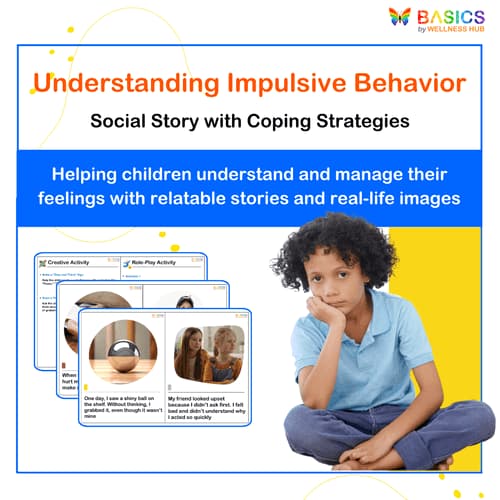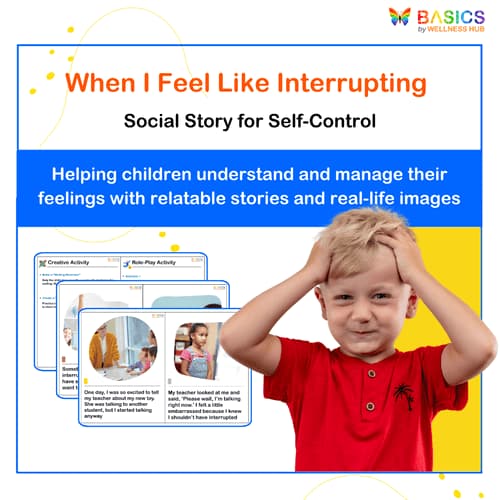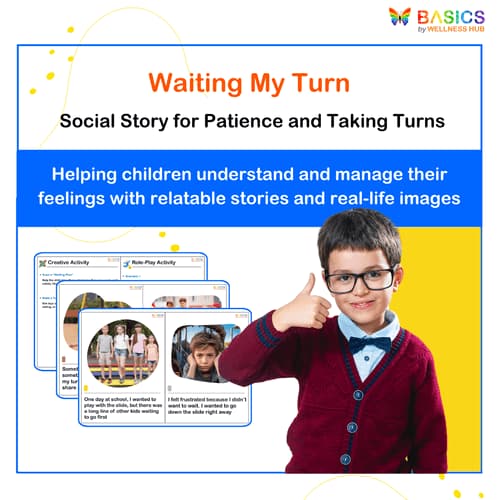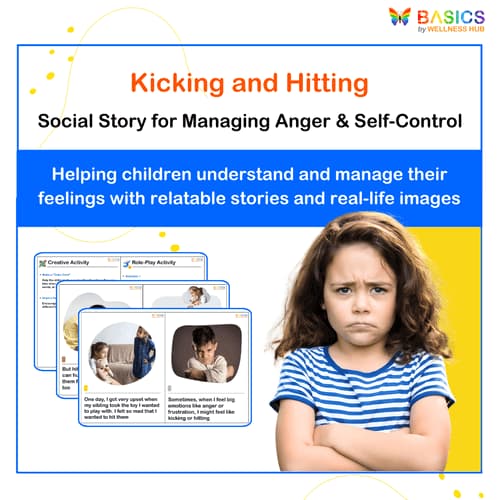





Understanding Good Touch and Bad Touch - A Child Safety Social Story
₹80
₹160
50% off
0 (0 ratings)
Grade Levels
Preschool - Grade 2 (Ages 3-7)
Content Overview
Format: 1 PDF, 8 pages Features: Real-life images, first-person narrative, easy-to-understand language
Categories
Pages from the Resource
This social story helps children understand the difference between good and bad touch in a safe and approachable way. Using real-life images and a first-person narrative, this resource teaches children how to recognize inappropriate situations and communicate with trusted adults.

Page 1

Page 2
What Users Say
0
0 ratings
5
0+
4
0+
3
0+
2
0+
1
0+
5 Stars
Product is Good to use.
10 months ago
Varsha Parent
Similar Products

Understanding Impulsive Behavior: Social Story with Coping Strategies
₹ 80.00
₹ 160.00
50% off
4.9 (42 ratings)

When I Feel Like Interrupting – Social Story for Self-Control
₹ 80.00
₹ 160.00
50% off
4.8 (60 ratings)

Waiting My Turn – Social Story for Patience and Taking Turns
₹ 80.00
₹ 160.00
50% off
4.7 (56 ratings)

Kicking and Hitting – Social Story for Managing Anger & Self-Control
₹ 80.00
₹ 160.00
50% off
4.6 (52 ratings)

Understanding Swear Words – Social Story for Respectful Communication
₹ 80.00
₹ 160.00
50% off
4.9 (48 ratings)
About the Product
Purpose of Flashcards: Teaching children about safe and unsafe touches is a vital part of early childhood education. The "Understanding Good Touch and Bad Touch" social story is designed to help children understand personal boundaries in a gentle and relatable way. This story is told from a first-person perspective, making it easier for children to connect with the content. With realistic images and clear statements, this resource addresses a delicate topic in a manner that is engaging and non-threatening.
Product Details
Format: 1 PDF
Total Pages: 8 pages
Content: High-quality real images paired with simple text for easy comprehension. Each page features two statements and corresponding images that guide children through the concept of good touch and bad touch.
Features: Interactive visual support, age-appropriate language, and clear messaging for kids.
Educational Benefits
Personal Safety: Helps children recognize the difference between safe and unsafe touches.
Emotional Awareness: Encourages children to understand and express their feelings when they feel uncomfortable or scared.
Boundary Setting: Teaches children to assertively communicate their boundaries and seek help from trusted adults.
Social Development: Builds confidence in understanding personal rights and when to ask for help.
Instructions for Use
Reading Together: Read the story with your child, ensuring they understand each concept before moving on to the next page. Pause to discuss any questions they may have.
Role Play: After reading, engage in role-playing scenarios where your child can practice saying “no” or telling a trusted adult if they feel uncomfortable.
Reinforcement Activities: Follow up with discussions or activities, like identifying trusted adults they can go to if they ever feel unsafe.
Repetition and Review: Revisit the story periodically to reinforce the lessons and ensure that your child retains the information over time.
Activities Using the Resource
Discussion Circles: After reading the story, gather the children in a circle and discuss the concepts of good touch and bad touch. Ask questions like, "What is a good touch?" and "How does a bad touch make you feel?" Encourage open communication and ensure that every child feels comfortable expressing their thoughts.
Role Play: Create scenarios where children can practice responding to different situations. For example, act out a scene where a child feels uncomfortable and needs to tell an adult. This activity helps children practice what they’ve learned in a safe environment.
Create a Safety Plan: Guide children in creating a personal safety plan. This can include identifying trusted adults they can talk to, knowing when and how to say “no,” and what to do if they feel unsafe. Children can draw or write their safety plan, which they can keep as a reference.
Art Activity: Have children draw pictures that represent safe spaces and trusted people in their lives. This can help them visually connect with the concepts of safety and trust. Discuss the drawings afterward to reinforce the message.
Story Sequencing: Print out the key scenes from the story and have the children put them in the correct order. This activity helps reinforce the storyline and ensures that the child understands the progression of events.
FAQs
Q1: What age group is this resource appropriate for?
A1: This resource is designed for children aged 3 to 8 years old, but it can be adapted for older children with developmental delays or special needs.
Q2: How can I ensure my child understands the concepts?
A2: Read the story slowly and discuss each page with your child. Use real-life examples and ask open-ended questions to gauge their understanding. Reinforce the lessons through role-playing and regular discussions.
Q3: What should I do if my child has questions about the content?
A3: Encourage your child to ask questions and answer them honestly and age-appropriately. If you're unsure how to answer, consider consulting a child psychologist or educator for guidance.
Q4: Can this resource be used in schools?
A4: Yes, this social story is suitable for use in schools, therapy settings, and at home. It’s an excellent tool for educators and therapists to introduce or reinforce the concept of personal safety.
Q5: How often should we revisit the story?
A5: It’s beneficial to revisit the story regularly, especially when the child is facing new social situations or environments. Periodic review helps reinforce the lessons and ensures the child remains confident in their understanding.
Usage Rights and Restrictions
Personal Use: This resource is intended for personal, educational, and therapeutic use only. You may print copies for individual use with your child or for small group settings like classrooms or therapy sessions.
Distribution: You may not distribute this resource, either digitally or in print, to others outside your immediate household or professional setting. For wider distribution, please purchase additional licenses or direct others to our website.
Modification: The content of this resource may not be altered or modified in any way. This includes the text, images, and overall design.
Commercial Use: This resource is strictly for non-commercial use. You may not sell, trade, or offer it as part of any product or service without explicit permission from the creators.
Conclusion
The "Understanding Good Touch and Bad Touch" social story is a valuable resource for helping children navigate the complexities of personal safety. With its approachable first-person narrative and real-life imagery, this story fosters a safe and supportive environment for children to learn about boundaries and how to protect themselves. By regularly engaging with this resource, parents, educators, and therapists can empower children with the knowledge and confidence they need to stay safe and seek help when needed. Remember, consistent reinforcement and open communication are key to ensuring that these important lessons are both understood and retained.



